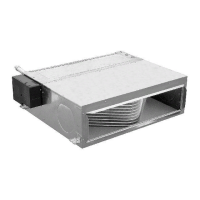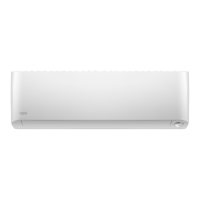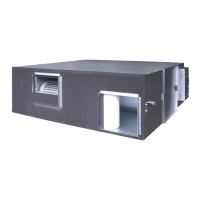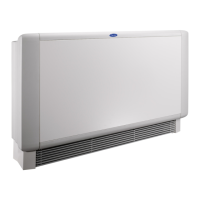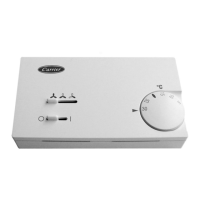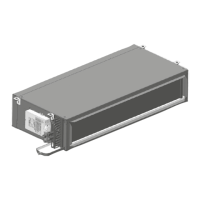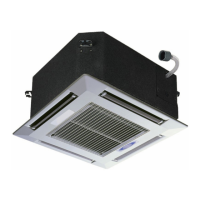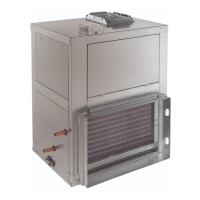SERVICE
Lock out and tag all power supphes to equipment and con-
trois prior to servicing unit. Follow all safety codes. Failure
to do so could result in personal injury.
Preventing Excessive Condensation on Unit --
Excessive condensation canbe causedby running chilled water
through a unit with the unit fan off. lffan cycling is used, a water
flow control valve should be installed to shut off the water when
ate fan mops.
Other methods of control winch avoid condensation prob-
lems are as follows:
1. If condensation is forming on ate unit, verify the chilled
water valve is closing off tightly. Dirt or debris may pre-
vent the valve from closing completely.
2. Continuous fan operation with motorized chilled water
valve controlled by a thermostat.
3. Continuous fan operation with thermostat control to
switch fan from high to low speed (instead of off).
Check Drain -- Cheek drain pan, drain line, and trap at
start of each cooling season. A standard type pipe cleaner for
3/4-in. ID pipe can be usad to be sure pipe is clear of obstruction
so that condensate is carried away. Cheek the drain line at filter
cleaning time during the cooling season. Be sure that debris has
not fallen into unit through supply air grille.
Fan Motor Bearings--Standard motors am perma-
nent split capacitor, which am equipped with permanently
sealed and lubricated bearings. No lubrication is required
unless special motors have been supplied or unusual operating
conditions exist.
Fan Shaft Ball Bearing -- The mid and inboard bear-
ings am permanendy sealed and lubricated. No additional
maintenance is required. The end bearings must be lubricated at
the start of each cooling and heating season. Add 5 to 10 drops
of SAE 20 or 30 non-detergent based oil to the beating.
Clean Fan Wheel -- For access to fan assembly, remove
discharge grille (if supplied). If unit is connected to ductwork,
remove front (40UV) or bottom (40UH) panel, separate fan
shaft from motor at bushing, remove motor, and slide fan
assembly from track. Use a stiff brush or vacuum to remove
dirt and debris from scroll. Wipe all fan surfaces with a damp
cloth. Reassemble as necessary.
Clean or Replace Air Filters -- At the start of each
cou]ing seasonand after each month of operation(more or less
depending on operating conditions), replace throwaway filter
or clean permanent filter.
THROWAWAY FILTER -- Replace filter with a good quahty
filter of ate correct size. Do not attempt to clean and reuse
disposable filters. See Table 1for filter sizes.
PERMANENT FILTER (FIBER TYPE)
1. Tap on solid surface to dislodge heavy particles.
2. Wash in hot water. If needed, usa mild solution of com-
mercial solvent such as sul soda or trisodium phosphate.
3. Set filter on end so that water drains out through slots in
frame. Allow filter to dry thoroughly.
4. Recharge filter with recharging oil. Three ounces is suffi-
cient for a medium size filter. Oil may be applied by insect
spray gun. For easier spraying, the oil can be warmed.
If the filter is dipped in ate recharging oil, remove it
immediately and allow to drain through slots in frame.
5. Replace filter in unit.
If another type of filter is used, follow ate filter manufactur-
er's instructions.
ECM Motor Removal and Reinstallation
(Fig. 9) -- Carrier unit ventilators utilize an electronically
commutated motor (ECM) to drive the indoor fan.
The ECM is a factory prograrmned motor that is standard
with factory-supplied controls (CCN) and units without
factory-supplied controls that are used in ingh-static apphca-
tions or high-capacity coils.
The ECM is programmed with an algorithm that maintains
a constant torque, as the static pressure on the system varies.
For example, as the filter pressure drop increases due to dirt,
the fan will increase speed (rpm) to maintain the cfin.
The ECM is identified by the two electrical receptacles
located on the housing. See Fig. 8A, 8B and 9.
The first receptacle is a 5-row in-line connector that feeds
ate motor line voltage. This may be either 115 volts or
230 volts. Units that are wired for 230 volts have a jumper be-
tween terminals 1and 2 on this plug (see wiring diagram).
The second receptacle on the motor is a 16-pin connector
and is used for speed switching. This is a low voltage (24-volt)
connection. Them is a jumper wire between terminals 1 and 3.
This is a 2,4-volt ground. Voltage is present at all times when
the motor is energized.
NOTE: A time delay exists between the time the motor speed
is switched and the motor's reaction. This is designed into the
electronics and does not indicate motor problems.
When replacing the motor, note ate following:
Check the part number of the old motor against that of
the replacement. There is a tag indicating the eight-digit
part number and begins with UVE. This is the program
number used for this motor.
• The motor must be installed per the instructions below.
It is important to maintain the dimension between the
fan compartment bulkhead and the coupling.
IMPORTANT: If a replacement cooling shroud has been
supplied, it should be installed and the old one
discarded. The motor shroud directs cooling air across
the motor to provide proper cooling. Never run the
motor without the cooling shroud in place. Ensure
the shroud inlet ring does not touch the motor; a gap of
t/j6 in. to ]/8 in. is acceptable.
Ensure the unit is completely assembled when checking the
fan speed. Replace all panels, including the filters, before
checking the fan for operation. When the internal pressure
drops at a normal condition, the loading on the motor will
be such that the fan can come up to seleetod speed.
Failure to ensure unit is completely assembled may
result in reduced life of unit and/or personal injury.
To remove and re-install the motors, proceed as follows;
refer Fig. 9:
I. Remove ate wire plugs from ate motor.
2. Remove ate 2 screws holding the motor shroud to the
bulkhead.
3. Slide ate shroud off ate motor to the right.
4. Loosen ate 3 setscrews on the shaft coupling between the
motor shaft and the fan shaft.
25

